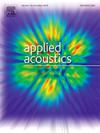Sound source localization based on three-element microphone array and RepMobileViT model
IF 3.4
2区 物理与天体物理
Q1 ACOUSTICS
引用次数: 0
Abstract
Traditional microphone array-based sound source localization methods typically begin with signal processing, where the source position is regarded as an estimated continuous value in a certain space. However, in some practical scenarios, such as conference rooms, source localization only needs to focus on some predefined areas, thus can be transformed into a deep learning classification problem. To solve the requirements of small size microphone arrays while maintaining the accuracy of source localization in reverberant environments, a feature extraction method based on sound intensity and an efficient lightweight model are proposed for the direction of arrival (DOA) estimation using a three-element microphone array. Firstly, two types of sound intensity feature spectrograms are designed to effectively extract sound source azimuth information under reverberant conditions. Secondly, the RepViT architecture is introduced into the MobileViT network to construct a new lightweight network, which estimates the source position with smaller parameters and faster speed. Finally, the sound intensity spectrogram is fed into the proposed model to estimate the DOA. Compared to existing methods, the proposed method exhibits more efficient and accurate performance in localizing with small arrays under simulated and real environments.
求助全文
约1分钟内获得全文
求助全文
来源期刊

Applied Acoustics
物理-声学
CiteScore
7.40
自引率
11.80%
发文量
618
审稿时长
7.5 months
期刊介绍:
Since its launch in 1968, Applied Acoustics has been publishing high quality research papers providing state-of-the-art coverage of research findings for engineers and scientists involved in applications of acoustics in the widest sense.
Applied Acoustics looks not only at recent developments in the understanding of acoustics but also at ways of exploiting that understanding. The Journal aims to encourage the exchange of practical experience through publication and in so doing creates a fund of technological information that can be used for solving related problems. The presentation of information in graphical or tabular form is especially encouraged. If a report of a mathematical development is a necessary part of a paper it is important to ensure that it is there only as an integral part of a practical solution to a problem and is supported by data. Applied Acoustics encourages the exchange of practical experience in the following ways: • Complete Papers • Short Technical Notes • Review Articles; and thereby provides a wealth of technological information that can be used to solve related problems.
Manuscripts that address all fields of applications of acoustics ranging from medicine and NDT to the environment and buildings are welcome.
 求助内容:
求助内容: 应助结果提醒方式:
应助结果提醒方式:


